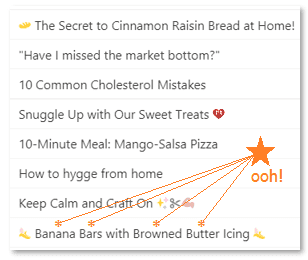I’ve packed it with examples from pop culture, sports, literature, and content marketing that’ll inspire you to infuse alliteration into your own creative writing.
I’ll also explain:
- How alliteration helped you learn letter sounds and develop memory skills when you were young;
- The differences between alliteration, assonance, and consonance;
- How freelance writers, bloggers, students, marketers, and literary greats use alliteration to touch the hearts and minds of readers.
Ready?
I’ll start with a quick alliteration refresher…

What is Alliteration?
Alliteration is a stylistic literary device that refers to the repetition of a closely connected series of multiple words with the same beginning consonant sound.
For example, here’s an all-too-true story that repeats the beginning “b” sound as a stressed syllable:
“Barbara baked banana bread, but it burned.”
(Bummer. )
Alliteration has been used for centuries to breathe life into the written (and spoken) word through the effect of the sounds of words.
For example, in the movie “V for Vendetta”, V’s self-introduction takes alliteration to the extreme. The effect of the string of “v” words certainly draws attention to his character through emphasis and tone:
The words of his speech tell his background story, but the repeated “v” sounds help viewers get a sense of his persona. The ominous impression of “V” is unforgettable.
This great example of alliteration demonstrates the power of verbal alliteration in film, but this technique has similar effects in written form.
Before we dig into the benefits of alliteration, let’s take a look at alliteration’s close cousins: assonance and consonance.
What’s the Difference Between Alliteration, Assonance, and Consonance?
There are two sound-based literary devices that are very similar to, and sometimes confused with, alliteration: assonance and consonance.
Assonance is the repetition of a vowel sound in a sentence, like “The squeaky wheel gets the grease.”
Consonance is a repeated consonant sound, like “All’s well that ends well.”
Repetitive sounds are the common factor between alliteration, assonance and consonance. Alliteration differs from the other two because it refers specifically to the initial consonant sound in words.
What are the Benefits of Alliteration, Assonance, & Consonance?
Due to the repetitive component of alliteration, assonance, and consonance, they are considered phonological mnemonic devices, which help to emphasize concepts and make passages more memorable.
Sound-based literary terms can also help to project a tone or mood with repeated sounds in words.
Alliteration is a multi-purpose literary device and its use can impact us in a variety of ways.
Truth be told, alliteration has benefited us from an early age, even before we could read.
The Evolution of Alliteration (in Our Lives)
Alliteration helps preschoolers learn letter sounds and develop memory skills.
We’re first introduced to alliteration through nursery rhymes and other children’s poetry:
- “Three gray geese in a green field grazing…”
- “Betty Botter bought some butter, but she said, this butter’s bitter; if I put it in my batter, it will make my batter bitter, but a bit of better butter will make my batter better…”
Children’s poet Shel Silverstein’s alliteratively titled nursery rhyme “The Gnome, The Gnat and The Gnu” hints of repeated “n” sounds that are found sprinkled throughout his alliteration poem. His stylistic spelling also serves as a fun way to teach children that the letters “gn,” “kn” and “n” all make the same sound:
I saw an ol’ gnome
Take a gknock at a gnat
Who was gnibbling the gnose of his gnu.
I said, “Gnasty gnome,
Gnow, stop doing that.
That gnat ain’t done gnothing to you.”
He gnodded his gnarled ol’ head and said,
“‘Til gnow I gnever gnew
That gknocking a gnat
In the gnoodle like that
Was gnot a gnice thing to do.”
Fun alliterative tongue twisters challenge children’s fast-talking skills:
- “Sally sells seashells at the seashore…”
- “Peter Piper picked a peck of pickled peppers…”
The lesson?
Alliterative children’s poetry and stories do more than simply teach phonics, entertain, or showcase snazzy and stylized repetition examples.
While pondering the pickled peppers peter piper picked and the pitter patter of tiny feet, children’s brains also work on associating meanings and emotional responses to sounds that they hear.
Intrigued? Read on.
Sound Symbolism: Labeling a Sound
Sounds of words actually reinforce their meaning and influence the interpretation of our language. Sound Symbolism is the recognition of the concept that sounds have a certain inherent meaning and enhance effective communication.
So, how are these sound symbolisms developed?
Symbolism of sounds is derived in part from how we create sounds with our mouths and vocal chords. We categorize sounds with an “internal catalog” of facial movements related to certain words combined with our awareness of how we physically form sounds and words with our mouths.
Try this:
Form your mouth like you’re going to say a word that starts with “sn.”
(Go ahead, nobody’s looking.)
You did that nasally pluggy-uppy maneuver with your tongue, didn’t you?
We’ve associated our nose with the vocalization of the “sn” sound. Not coincidentally, many words that are related to the nose and mouth start with “sn,” like snore, snout, sniff, snoop and sneeze.
Skillful use of alliteration emphasizes a tone or mood through rhythmically repeated sound, eliciting a response to the “internal sound symbolism catalog” that we all share.
Joni Mitchell wrote the alliterative opening song lyrics to her 1970 hit, “Big Yellow Taxi” to set the tone of her message. Listen to the repeated “p” words that project her “spitting mad” mood about what’s happening in her world:
“They paved paradise and put up a parking lot…”
Let’s take a look at some examples of alliteration in our everyday lives that help us remember things.
Pop Culture: What’s in an Alliterative Name?
Plenty of science and thought is put into naming consumer products or brands. Here are some business and brand names that have obvious mnemonic qualities:
- Dunkin’ Donuts
- Krispy Kreme
- Bath & Body Works
- Bed, Bath & Beyond
- LuluLemon
- Coca-Cola
- Best Buy
- American Airlines
- PayPal
- American Apparel
Sports team franchise names that make the all-alliteration team are:
- Los Angeles Lakers
- Buffalo Bills
- Pittsburgh Pirates (and Penguins)
- Seattle Seahawks
We often hear alliteration in music and film artists’ names. These famous television, film, sports and political figures were given a natural edge on popularity with their alliterative names:
- Ronald Reagan
- Mickey Mantle
- Katie Courec
- Jesse Jackson
- Lucy Liu
We can only wonder if Norma Jean Mortenson’s popularity and success was aided by the act of changing her name to Marilyn Monroe. Other celebrity artists that adopted alliterative stage names are:
- Backstreet Boys
- Beastie Boys
- Dr. Dre
- Counting Crows
- Foo Fighters
Many character names in children’s cartoons, books, or movies are peppered with alliteration. To highlight his importance, main character Spongebob Squarepants’ name is alliterative, but his friends’ names are not. Some others:
- Mickey Mouse & Minnie Mouse
- Big Bird
- Donald Duck
- Peppa Pig
- Bugs Bunny
Marvel Universe superheroes’ real identities and supporting characters were deliberately named alliteratively by creator, Stan Lee. Curiously, he admitted in an interview that he decided to use first and last names with the same initial sound to make it easier to keep them straight in his own mind! To name a few:
- Bruce Banner
- Reed Richards
- Sue Storm
- Peter Parker
- J. Jonah Jameson Jr.
- Fin Fang Foom
Harry Potter author J. K. Rowling artfully named supporting characters using various literary devices. Here are a few examples of alliterative names in the series:
- Luna Lovegood
- Severus Snape
- Salazar Slytherin
- Godric Gryffindor
- Helga Hufflepuff
Demonstrated by Ms. Rowling, the use of alliteration in literature helps readers remember characters in a story.
But writers can also use an alliterative phrase to emphasize a passage or develop a certain tone by repeating a similar sound. Let’s dive into some creative alliteration examples in literary classics.
Examples of Alliteration in Literature
In poetry and prose, alliteration and other sound devices like rhythm help create a tone or mood, suggest a tempo, and emphasize certain words or phrases.
Alliteration In Poetry
This following stanza of The Rime of the Ancient Mariner by Samuel Taylor Coleridge demonstrates his poetic use of sound-based literary devices in his work. Alliteration ties the words of the poem together as well as creating rhythmic and pleasant sounds:
“The fair breeze blew, the white foam flew,
The furrow followed free;
We were the first that ever burst
Into that silent sea.”
Alliteration helps to suggest an eerie rhythm of Edgar Allan Poe’s poem, “The Raven.” Notice the alliteration pairs in the first three stanzas:
“Once upon a midnight dreary, while I pondered, weak and weary,
Over many a quaint and curious volume of forgotten lore—
While I nodded, nearly napping, suddenly there came a tapping,…”
William Shakespeare used “f” sounds and “l” sounds to create images of death and life, respectively, in his prologue of “Romeo and Juliet”:
“From forth the fatal loins of these two foes;
A pair of star-cross’d lovers take their life.”
Alliteration In Prose
In “To Kill a Mockingbird”, Harper Lee used alliterative descriptions of families and places to emphasize the importance of these entities in her novel. With a heavy emphasis on “s” sounds, the town of Maycomb is described:
“…grass grew on the sidewalks, the courthouse sagged in the square… a black dog suffered on a summer’s day; bony mules… flicked flies in the sweltering shade of the live oaks on the square…”
Alliteration In Speeches
Due to its rhetorical nature, alliteration appears in many famous speeches in which sound-based literary devices like alliteration (and onomatopoeia) help to set a tone.
For example, Abraham Lincoln’s Gettysburg Address opens demanding attention with repetitive “f” sounds:
“Four score and seven years ago our fathers brought forth on this continent a new nation…”
Another great example is Martin Luther King’s “I Have a Dream” speech, which emphasized his dream for his children by repeating the hard “c” sound:
“I have a dream that my four little children will one day live in a nation where they will not be judged by the color of their skin but by the content of their character.”
These classic examples demonstrate that alliteration, used with other literary devices, helps readers develop sensory and emotional connections with words. That connection in turn helps to build a stronger understanding of the passages.
Ready to see how contemporary content writers artfully use alliteration to emotionally connect with their readers?
Examples of Alliteration in Content Marketing
We all know that the purpose of content marketing is to make a connection with our readers and inspire them to take action.
To that end, we’ve learned that we can use alliteration, power words, sensory words, and other writing devices and tools to create sensory and emotional connections with our readers. This emotional connection can help persuade our readers to take action.
Alliteration helps call attention to headlines, subheads, and email subject lines, but alliteration can also help to emphasize a point:
“Smart speakers, as well as their speechwriters, sprinkle their speeches with carefully-chosen power words…”
– Jon Morrow
Let’s feel the power of some alliterative subject lines:
Pack a Punch With Alliterative Headlines
Alliterative phrases in these headlines call attention to the message and emphasize their purpose through alliteration:
- 57 Metaphor Examples That’ll Pack Your Prose With Persuasion
- How to Become a Freelance Writer, Starting from Scratch
And, this power words headline gets alliteration bonus points:
The rapid-succession Pack-a-Punch and Convert-like-Crazy plosive alliteration combo exerts an authoritative influence of Power like the old one-two. (Hard beginning consonant sounds create a sense of authority, but more on that later.)
Stop Scanners with Alliterative Subheads
Subheads serve several purposes, primarily to help organize your content for the reader. Alliteration can stop “subhead scanners” in their tracks by eliciting an emotional connection through sound symbolism, like these:
This one demands attention:
Polish Your Post So It’s Smoother Than a Slip ‘n Slide
– from How to Write a Blog Post in 2024: The Ultimate Guide
And this subhead…
Make Money by Creating Collateral for Content-Hungry Business
– from How to Make Money Writing: 5 Ways to Get Paid to Write in 2024
…leads readers into this alliterative text:
“In the last five years, content marketing — this concept of creating valuable content to attract customers and build credibility and trust — has undoubtedly gone mainstream.”
Get Clever With Alliterative Calls to Action
Email subject lines that use alliteration spark a call to action by projecting a certain tone or mood, connecting with the reader on an emotional or sensory level.
Here are some clever alliterative subject lines of email received while sheltering in place during the COVID-19 pandemic:

These alliteration examples show us how we can make a memorable impact by emphasizing a point or projecting a feeling or a mood.
Ready to put alliteration to the test? Let’s start with a little experiment.
Alliteration: Testing the Tone
But how can we use alliteration in content writing to be more persuasive and memorable?
Circling back to the concept of sound symbolism, we learned that sounds have inherent meanings. Let’s see how effective those inherent meanings are when they’re emphasized in alliterative phrases.
If you recall, we recognized the strength of the alliterative beginning word sounds in:
801+ Power Words That Pack a Punch and Convert like Crazy
But not all sounds are created equally.
To demonstrate, we’ve replaced the original alliteration with other alliterative words that express a similar concept:
XX Power Words That’ll Steal the Show and Woo like Wonder
Our revised alliterative headline falls flat because sibilant “s” and airy “w” sounds aren’t as authoritative as the original plosive “p” and hard “c” sounds.
Clearly, we need to pay attention to projected tones of sounds when using alliteration.
Alliterative Effect: How to Use it
Reverse-engineering successful alliteration begins with understanding the effect of beginning word sounds.
Match the Sound to the Mood
Beginning consonant sounds are associated with a combination of two physical actions when we vocalize the sound:
- Voiced or Voiceless (whether the vocal cords are used to make the sound), and
- Fricatives vs. Stops (whether or not air is pushed from or stopped at the mouth).
Hard consonant sounds that are typically voiceless or stops, and will have a plosive sound that can elicit a sense of authority or abruptness.
Conversely, some soft consonant sounds are typically voiced or fricatives. They can be soft and breathy, eliciting a more soothing tone. Other soft consonant sounds like “s” or “z” are sibilant, suggesting malice or slyness.
Alliteration Tip #1:
A key to successful use of alliteration is to match the effect of beginning sounds of words to project the desired effect of your writing.
Test Out A Tool
Stuck for an alliteration? Need help crafting a tongue twister?
Poem Generator has several writing aids to suggest phrases or passages to writers. Among these tools is an Alliteration Generator. Simply key in a word or sentence that you’d like to alliterate, and the generator returns a list of options.
We tested the tool by entering:
“Let the tool do the work.”
Our results included several options including:
“Let the tired, trustworthy tool do the wooden, witty work.”
Obviously, a tool doesn’t possess your creativity and judgement, so use it as an aid instead of an end. Results vary!
Alliteration Tip #2:
Solicit the help of alliteration generators to suggest an alliterative word, but remember that your creativity far outweighs any software program.
Give It a Go, But Don’t Go Gaga
Once you get the hang of alliteration, you may be tempted to use it more often than you should. Don’t!
Simply said, sentences with a surplus of similar sounds in successive words will sound silly and somewhat stupid!
Alliteration Tip #3:
Don’t go overboard with alliteration in your creative writing. Like all powerful tools, you need to use alliteration sparingly.
Add Alliteration to Your Toolkit
Ready to make better connections with your readers?
Draw your inspiration from these alliteration examples to help your readers feel the effect of your message.
Remember, even though it’s an example of figurative language, alliteration is all about sound.
Sound can help you emphasize a key point or convey a tone by deliberately selecting suitable words.
Make a sensory impact by selecting beginning word sounds for their symbolism and repeating them to intensify the effect.
Then, take pride in your work’s alliterative transition from:
- dull to dramatic,
- trite to tantalizing or
- boring to badass!
You get the idea!







